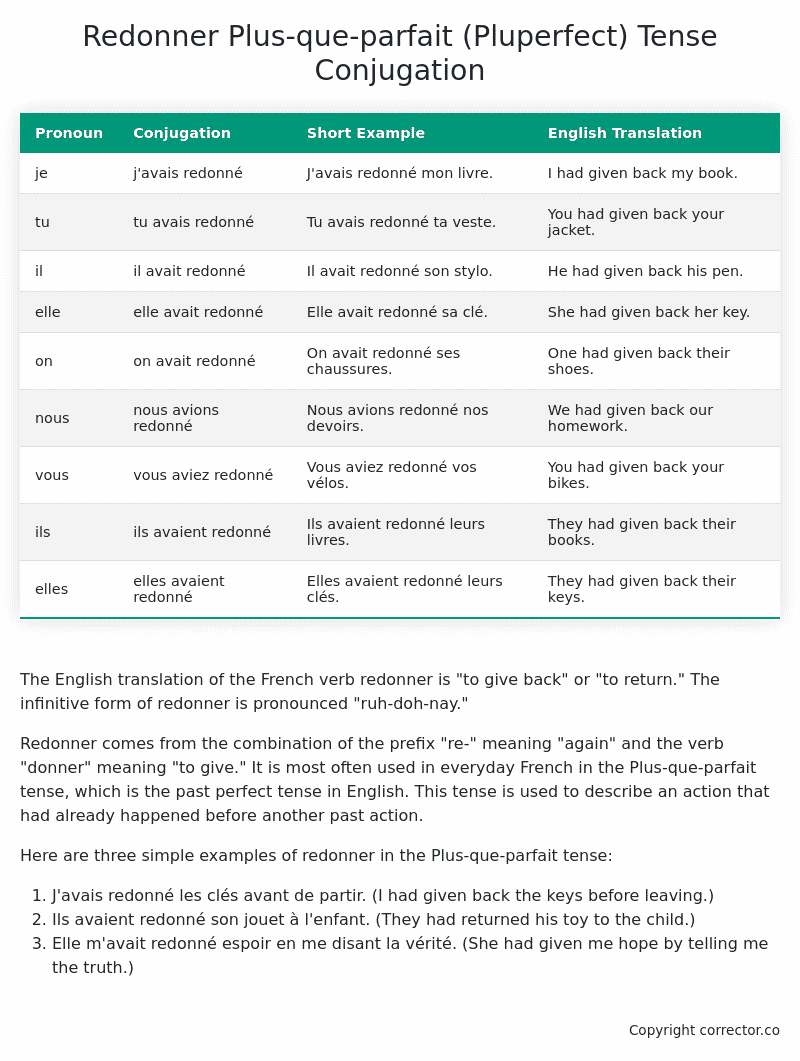Plus-que-parfait (Pluperfect) Tense Conjugation of the French Verb redonner
Introduction to the verb redonner
The English translation of the French verb redonner is “to give back” or “to return.” The infinitive form of redonner is pronounced “ruh-doh-nay.”
Redonner comes from the combination of the prefix “re-” meaning “again” and the verb “donner” meaning “to give.” It is most often used in everyday French in the Plus-que-parfait tense, which is the past perfect tense in English. This tense is used to describe an action that had already happened before another past action.
Here are three simple examples of redonner in the Plus-que-parfait tense:
- J’avais redonné les clés avant de partir. (I had given back the keys before leaving.)
- Ils avaient redonné son jouet à l’enfant. (They had returned his toy to the child.)
- Elle m’avait redonné espoir en me disant la vérité. (She had given me hope by telling me the truth.)
Table of the Plus-que-parfait (Pluperfect) Tense Conjugation of redonner
| Pronoun | Conjugation | Short Example | English Translation |
|---|---|---|---|
| je | j’avais redonné | J’avais redonné mon livre. | I had given back my book. |
| tu | tu avais redonné | Tu avais redonné ta veste. | You had given back your jacket. |
| il | il avait redonné | Il avait redonné son stylo. | He had given back his pen. |
| elle | elle avait redonné | Elle avait redonné sa clé. | She had given back her key. |
| on | on avait redonné | On avait redonné ses chaussures. | One had given back their shoes. |
| nous | nous avions redonné | Nous avions redonné nos devoirs. | We had given back our homework. |
| vous | vous aviez redonné | Vous aviez redonné vos vélos. | You had given back your bikes. |
| ils | ils avaient redonné | Ils avaient redonné leurs livres. | They had given back their books. |
| elles | elles avaient redonné | Elles avaient redonné leurs clés. | They had given back their keys. |
Other Conjugations for Redonner.
Le Present (Present Tense) Conjugation of the French Verb redonner
Imparfait (Imperfect) Tense Conjugation of the French Verb redonner
Passé Simple (Simple Past) Tense Conjugation of the French Verb redonner
Passé Composé (Present Perfect) Tense Conjugation of the French Verb redonner
Futur Simple (Simple Future) Tense Conjugation of the French Verb redonner
Futur Proche (Near Future) Tense Conjugation of the French Verb redonner
Plus-que-parfait (Pluperfect) Tense Conjugation of the French Verb redonner (this article)
Passé Antérieur (Past Anterior) Tense Conjugation of the French Verb redonner
Futur Antérieur (Future Anterior) Tense Conjugation of the French Verb redonner
Subjonctif Présent (Subjunctive Present) Tense Conjugation of the French Verb redonner
Subjonctif Passé (Subjunctive Past) Tense Conjugation of the French Verb redonner
Subjonctif Imparfait (Subjunctive Imperfect) Tense Conjugation of the French Verb redonner
Subjonctif Plus-que-parfait (Subjunctive Pluperfect) Tense Conjugation of the French Verb redonner
Conditionnel Présent (Conditional Present) Tense Conjugation of the French Verb redonner
Conditionnel Passé (Conditional Past) Tense Conjugation of the French Verb redonner
L’impératif Présent (Imperative Present) Tense Conjugation of the French Verb redonner
L’infinitif Présent (Infinitive Present) Tense Conjugation of the French Verb redonner
Struggling with French verbs or the language in general? Why not use our free French Grammar Checker – no registration required!
Get a FREE Download Study Sheet of this Conjugation 🔥
Simply right click the image below, click “save image” and get your free reference for the redonner Plus-que-parfait tense conjugation!

Redonner – About the French Plus-que-parfait (Pluperfect) Tense
Tense Formation
Common everyday usage patterns
Sequencing of past events
Background information
Hypothetical or reported speech
Interactions with other tenses
Summary
I hope you enjoyed this article on the verb redonner. Still in a learning mood? Check out another TOTALLY random French verb conjugation!


